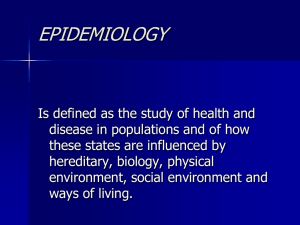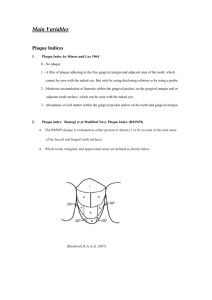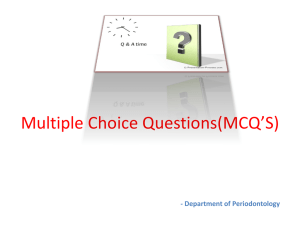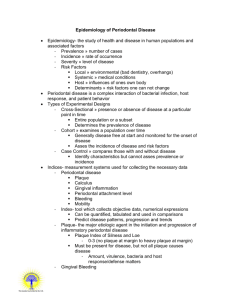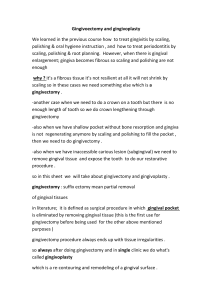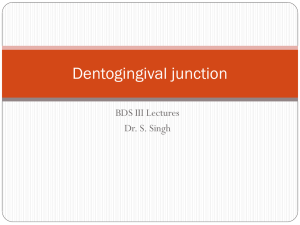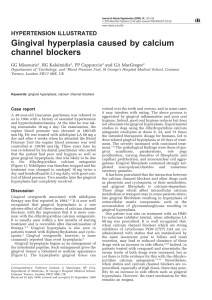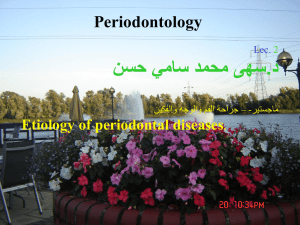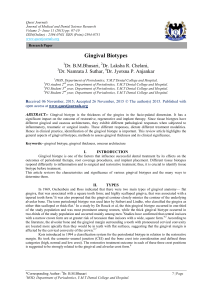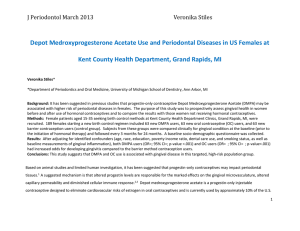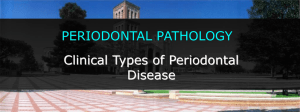Gingival Diseases - University of New Haven
advertisement
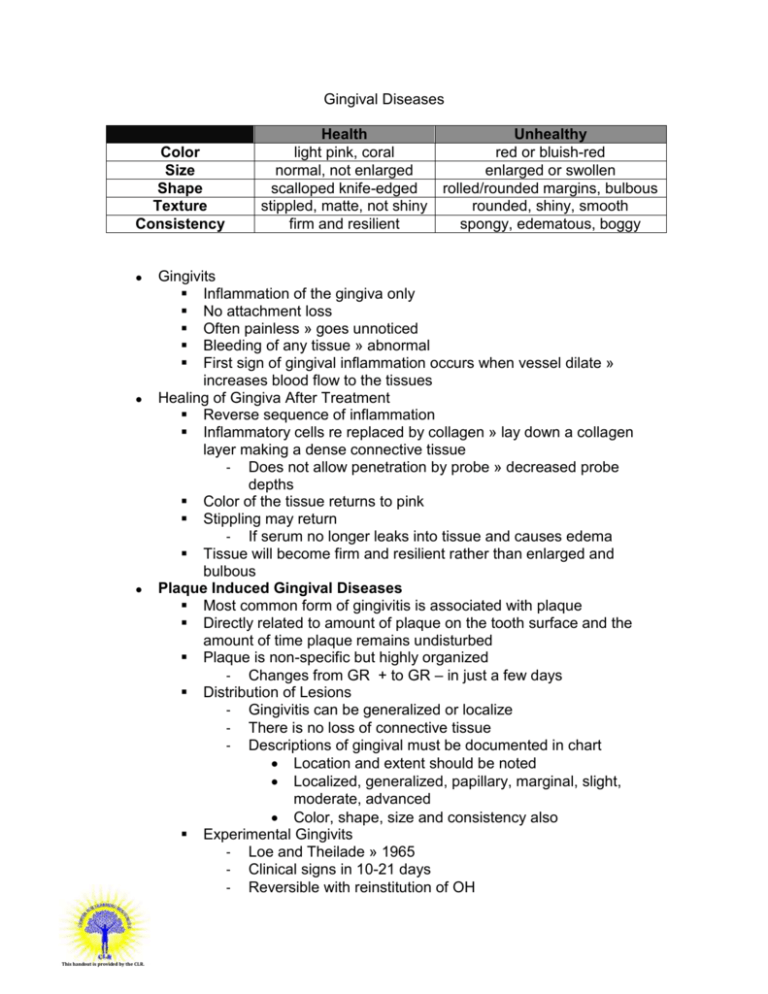
Gingival Diseases Color Size Shape Texture Consistency This handout is provided by the CLR. Health light pink, coral normal, not enlarged scalloped knife-edged stippled, matte, not shiny firm and resilient Unhealthy red or bluish-red enlarged or swollen rolled/rounded margins, bulbous rounded, shiny, smooth spongy, edematous, boggy Gingivits Inflammation of the gingiva only No attachment loss Often painless » goes unnoticed Bleeding of any tissue » abnormal First sign of gingival inflammation occurs when vessel dilate » increases blood flow to the tissues Healing of Gingiva After Treatment Reverse sequence of inflammation Inflammatory cells re replaced by collagen » lay down a collagen layer making a dense connective tissue - Does not allow penetration by probe » decreased probe depths Color of the tissue returns to pink Stippling may return - If serum no longer leaks into tissue and causes edema Tissue will become firm and resilient rather than enlarged and bulbous Plaque Induced Gingival Diseases Most common form of gingivitis is associated with plaque Directly related to amount of plaque on the tooth surface and the amount of time plaque remains undisturbed Plaque is non-specific but highly organized - Changes from GR + to GR – in just a few days Distribution of Lesions - Gingivitis can be generalized or localize - There is no loss of connective tissue - Descriptions of gingival must be documented in chart Location and extent should be noted Localized, generalized, papillary, marginal, slight, moderate, advanced Color, shape, size and consistency also Experimental Gingivits - Loe and Theilade » 1965 - Clinical signs in 10-21 days - Reversible with reinstitution of OH This handout is provided by the CLR. Plaque Induced Gingivitis Modified by Local Factors - Malposed or crowed teeth - Overhanging restorations - Overcontoured restorations - Orthodontic bands All plaque traps Dot not cause disease of aid or intensify the gingival response Gingival Disease Modified by Systemic Factors - Circulating corticosteroids Associated with stress or steroid type hormones Produced by hormonal or endocrine system changes o During menstruation or pregnancy - Increase in subgingival bacteria such as Bacteroides and increase in serum concentrations of estrogen during pregnancy Gingiva reacts more sensitively to plaque and poor plaque control aggravates May turn bright red and bleed much easier May become hypoplastic Pregnancy tumor (pyogenic granuloma) may occur - Patients taking oral contraceptive or older patient taking a hormone replacement Gingival Diseases Modified by Medication - Seizure medications can cause hyperplasia - Phenytoin or dilantin - Immunosuppressive drugs or cardiac meds can cause excessive accumulation of connective tissue in many other tissues of the body Cyclosporine or verapamil (calcium channel blocker) Nifedipine (procardia) (calcium channel blocker) Gingival Disease Modified by Malnutrition - Vitamin A, B1, B2, B6 or C - C deficiency can cause scurvy Results in defective collagen formation and maintenance Gingiva may hemorrhage and become swollen Condition can progress to advanced periodontitis and cause extensive bone and tooth loss Non Plaque Induced Gingivitis Gingival Diseases of Specific Bacterial Origin - Streptococcal infections of the throat and oral tissues in young children - Syphilis - Gnonorrhea - Necrotizing Ulcerative Gingivitis This handout is provided by the CLR. Can occur with no bone loss and a bacterial component Common in WWI » poor oral hygien in trenches “trench mouth” Begins in IDP and tips become blunted/punched out IDP covered in a white necrotic pseudomembrane o Collection of PMN’s trapped in a fibrin clot Distinctive breath odor » fector oris Caused by fusiform bacillus bacteria and a spirochete o Vincents organisms Routine treatment » debridement (gentle to prevent further damage and OHI Systemic antibiotics such a penicillin and metronidazole are useful o Recommended only for patients with fever and severe malaise Gingival Diseases of Viral Origin - Primary herpetic gingivostomatitis or primary herpes infection - fever blisters or cold sores - similar symptoms to ANUG however a higher temp and patient appears more ill with greater malaise - vesicles form which may coalesce into ulcerative lesions - no punched out IDP - odor but not as distinctive as fector oris Gingival Diseases of Fungal Origin - Candidiasis is caused by a yeast organism Candida albicans Gingival reddens » linear gingival erythema White patches of organisms and debris that can easily be rubbed off to expose ulcerative tissue Common in young kids on palate Gingival Lesions of Genetic Origin - Cause gingival enlargements - Idiopathic gingival enlargement of an unknown origin Gingival Manifestation of Systemic Conditions - Blood dyscrasias - Acute leukemia Hemorrhagic and swollen gingival Far more pronounced than amount of plaque and calculus present Very life threatening disease Gingival Manifestations of Dermatologic Conditions - Lichen Planus Chronis disease thought to be immune related This handout is provided by the CLR. Affects skin and mucous membranes Men and women are equally effects Reticular form » lacy white lines on gingival called Wickham’s striae Rare erosive form » bulbous, portions of the lesions become ulcerative and painful o Can transform into squamous cell carcinoma Topical steroids can treat but there is no cure - Benign Mucous Membrane Pemphigoid Cicatricial pemphigoid Chronic vesiculobullous disease Blistering and sloughing of surface epithelium o Raw, painful bleeding areas o Skin strips away when rubbed » Nikolsky’s strips Unknown origin o Considered to be autoimmune Common in older individuals and females On buccal mucosa and inner lip surfaces Pallative treatment with topical corticosteroids Systemic steroids also ease symptoms - Desquamative Gingivitis or Gingivosis Cicatricial pemphgoid limited to gingival tissues Autoimmune Meticulous plaque control may help of this is often difficult due to painful lesions Topical steroids and systemic steroids may help - Traumatic Lesions Damage to gingival tissue Burns » aspirin placed on gingival relieves pain Cuts Some lesions can be severe enough to lead to advanced recession Foreign Body Reactions Lesions or damage can be acute Often localized painful lesions with sudden onset Removal of source will bring immediate relief
